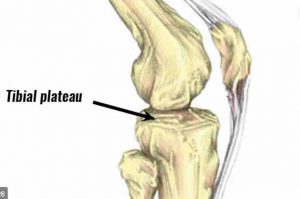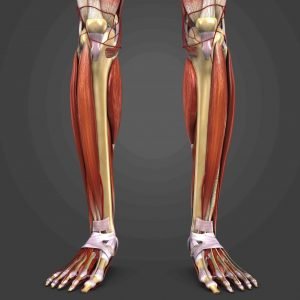Broken Shin
 Typically fractured from traumatic force, the tibia, or shinbone remains the most commonly fractured long bone in the human body. Located just below the knee, the tibia often fractures in conjunction with the bone next to it, the fibula. A vital part of the knee joint and ankle joint, the tibia bears much of an individuals weight. Doctors often see broken shins in motor vehicle accidents and sports injuries.
Typically fractured from traumatic force, the tibia, or shinbone remains the most commonly fractured long bone in the human body. Located just below the knee, the tibia often fractures in conjunction with the bone next to it, the fibula. A vital part of the knee joint and ankle joint, the tibia bears much of an individuals weight. Doctors often see broken shins in motor vehicle accidents and sports injuries.
Symptoms of a broken shin
When an individual has a broken shin, or tibia, the patients typically feels instant and intense pain in the lower leg. Symptoms of a fractured tibia include:
- Inability to walk or place any weight on the affected leg
- Bone penetrating the skin
- Visible deformity of the skin
- Numbness or inability to feel the foot on the affected leg
Types of shin fractures
Types of tibia fractures vary and depend on the type, location, and amount of force used to fracture the bone. When evaluating a broken shin, doctors use a known system to classify what type of fracture occurred. To determine the classification, doctors use characteristics of the fracture including the location and pattern of the fracture, in addition to whether an open injury occurred.
After evaluating the injury using a physical examination and diagnostic testing, the sports medicine surgeon classifies the exact type of fracture. For fractures of the tibia, doctors primarily see five different types of fractures. These fractures include:
- Transverse Fracture: In a transverse fracture, the tibia has a horizontal fracture across the tibial shaft.
- Oblique Fracture: Oblique fractures exhibit a diagonal or angular line across the tibial shaft
- Spiral Fracture: Caused from a twisting motion, in spiral fractures the fracture line circles around the tibia like a spiral staircase.
- Comminuted Fracture: In comminuted fractures, the bone breaks in three or more pieces.
- Open Fracture: Also called a compound fracture, an open fracture occurs when the bone breaks in a way that the fragments puncture and rip through the skin.
Treatment of a broken shin
Fractures of the tibia typically require surgical treatment. In certain cases, doctors may use non-surgical treatment depending on the patient’s overall health, activity level, and degree of injury. For nonsurgical treatment, the doctor  may start with a splint to provide stability to the injury. Once the initial swelling from the injury goes down, the physician utilizes casting and eventually bracing.
may start with a splint to provide stability to the injury. Once the initial swelling from the injury goes down, the physician utilizes casting and eventually bracing.
For those having to undergo surgical treatment, the surgeon uses intramedullary nailing, plates and screws, or external fixation. With the current preferred method, intramedullary nailing, the surgeon inserts a metal rod into the canal of the tibia. The rod goes through the fracture to keep it in position and maintain stability. The surgeon then screws the intramedullary nail to the bone at both ends which keeps the nail and bone in the appropriate position to heal.
To view a list of all insurances that AOA Orthopedic Specialists accept, click HERE. To schedule an appointment online, click HERE
EXPERIENCING BODY ACHES AND PAINS? CALL 817-375-5200 TO SCHEDULE AN APPOINTMENT WITH AN AOA ORTHOPEDIC SPECIALIST TODAY!
F.A.Q.
How is a broken shin diagnosed?
A physical examination, symptom evaluation, and imaging tests such as X-rays or CT scans are often used to make a diagnosis. These examinations aid in determining the location, kind, and severity of the fracture.
How long does it take for a broken shin to heal?
The length of recovery time depends on the severity of the fracture and the individual’s overall condition. Simple fractures may heal in 6 to 8 weeks, however, more severe fractures may require a longer healing period.
What is the rehabilitation process after a broken shin?
Rehabilitation and physical therapy are required after the initial healing phase to restore strength, mobility, and function in the damaged leg. Under the supervision of a healthcare practitioner, these programs often include exercises, stretching, and gradual weight-bearing activities.
Can complications arise from a broken shin?
Complications are possible, but they are uncommon. Infection, delayed healing, nonunion (failure of the bone to mend), malunion (improper alignment during healing), nerve or blood vessel injury, or compartment syndrome are all possibilities. Prompt medical attention and treatment assist to reduce the risk of problems.

